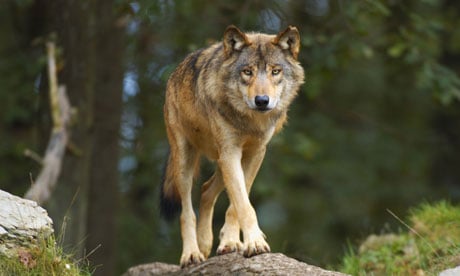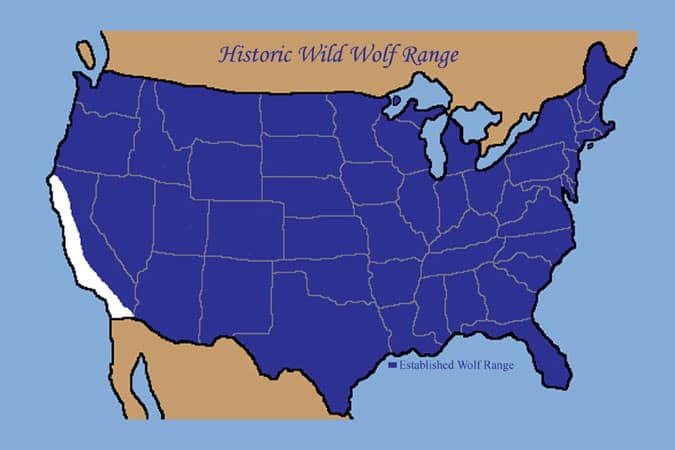
I had been saving these two New Scientist articles and since we’ve been discussing wolves..Here’s the link to how gray wolves are faring in Europe..and one on how prey react based on Yellowstone.
GOODNESS, what big teeth you have, and what close ties to humans you have! And what negative attitudes you elicit from rural people all over the world!
Behind their cultural baggage, grey wolves are an evolutionary success story, giving rise to the domestic dog 10,000 years ago and, more recently, rebounding from centuries of persecution.
“There are wild wolves galore in Europe,” says Claudio Sillero, a conservation biologist at the University of Oxford. “They have recolonised vast areas of their former range and live almost unnoticed in populated areas.”
A wolf was recently spotted in the Netherlands, after an absence of over a century. There are ongoing calls from ecologists for them to be reintroduced to Scotland, where they’ve been extinct since the 1700s. In the US, arguments rage over whether their numbers are high enough to sustain hunting.
These wolves were photographed playing in the Black Mountain Wildlife Park, south of Hamburg in Germany, which has more than a thousand animals in an area of 50 hectares.
“While we think of wolves as masters of the wilderness in Europe, they thrive in human-dominated landscapes,” says Sillero. “Over 3000 wolves live in heavily populated areas of northern Spain and Portugal, and wolves from Italy have steadily colonised southern France.”
French farmers may not share Sillero’s enthusiasm, but with less persecution than in the past, wolf numbers are growing. For those of us in Europe, the howl of a wolf could one day become as familiar as the cries of foxes.
And “Scared to death: How intimidation changes ecosystems
IN JANUARY 1995, grey wolves returned to Yellowstone National Park, almost 70 years after they had been exterminated by an overenthusiastic predator-control programme. Over the next two winters, 31 animals captured in Canada were released into the park, fitted with radio collars so that rangers could track their whereabouts. But not all eyes were on the wolves; John Laundre was more interested in their main prey, elk. The large deer had run amok in the wolf-free decades, causing serious damage to the park’s trees. He wanted to know how they would fare now that their old nemesis was back.
By the second year, the answer was obvious. In the parts of Yellowstone that the wolves hadn’t yet reached, female elk grazed peacefully while their calves gambolled around them. “It was a scene out of a Disney film,” says Laundre, an ecologist at the State University of New York at Oswego. But in areas the wolves had colonised, things were very different. The calves were pinned to the sides of their ever-wary mothers. “It was like looking at two different countries, one at war and one at peace,” he says.
For Laundre, it was a light-bulb moment. He realised that wolves don’t just kill elk, they also change the deer’s behaviour without even lifting a claw. Their mere presence – perhaps their scent on the wind and tracks in the dirt – creates a perpetual state of apprehension in their prey. Seen through the eyes of an elk, the physical terrain is overlaid with a mental map of risk, complete with “mountains” where the odds of being eaten are high and they must be constantly vigilant, and “valleys” of relative safety where they can lower their guard. To describe this psychological environment, Laundre coined the term “landscape of fear”.
The concept seems simple but it subverts the dominant view in ecology – that predators only affect their prey by killing them. It also challenges the belief that most animals feel fear only in short bursts, like the sharp panic of a chase, while long-term psychological stress is something that only humans and other primates experience. With such emotions pushed aside, traditional ecological models have reduced predators and prey to little more than rolling marbles. “If one bumped into another, the second ball was dead,” says Laundre. The idea of adding psychology to the mix, especially a seemingly anthropomorphic emotion like fear, was anathema.
But times are changing. Ecologists are studying landscapes of fear in animals as diverse as wolves and elk, sharks and dugongs, spiders and grasshoppers. Time and again it has emerged that the greatest effect predators have upon their prey is not through slaughter, but intimidation. They can influence how successfully their potential victims feed, breed and raise their young, all without a single kill. And it doesn’t end there: these effects trickle through entire ecosystems, shaping the make-up of the local flora and even influencing the flow of nutrients through the soil. The implications are huge. Through the landscape of fear, predators can unwittingly remodel the physical landscape – just by being scary.
Laundre wasn’t the first to recognise the role of fear in ecology. Since the 1970s, studies had shown that predators can force prey to mount costly defences, such as moving into poorer habitats and being so relentlessly vigilant that they do not have the time to eat enough. But most of these experiments were small in scale and duration, and few looked at the lasting consequences of the choices made by prey. It was the advent of big, long-term studies in natural settings that addressed these failings and brought the importance of fear into sharp relief.
“The Yellowstone example is the first one that really smacked us in the face,” says Laundre. Before the wolves were reintroduced, ecologists correctly predicted how big their populations would become and how many elk they would kill. However, they greatly underestimated the effect on elk numbers. “They really just assumed that wolves would impact the elk by eating them,” says Scott Creel from Montana State University in Bozeman, whose findings in another corner of Yellowstone showed how wrong that idea was.
While hunting for a photo, I found this by Garry Marvin on the return of wolves to the UK.
The solution is not imposition but dialogue. Conservation projects, however soundly based on science, can never succeed without taking account of the human dimension. Wildlife has to co-exist with humans. Put crudely, scientists often seem frustrated that local people do not understand what they tell them about the realities of wolves; shepherds and other livestock farmers feel resentful that outsiders do not want to listen to their traditional knowledge; and agricultural agencies seem to think that compensation for animals killed is payment enough for wolf predation.
Hmm.. sound familiar?

